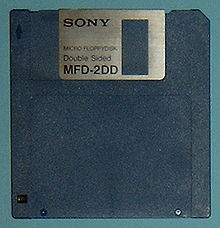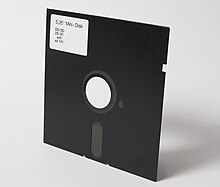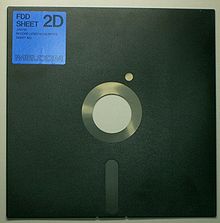Double density
Double Density , abbreviated to DD or 2D , is one of several possible recording densities on floppy disks . It is used for 3 ", 3.5", 5.25 ", and 8" floppy disks with a physical storage capacity of approximately 100 KB up to approximately 1 MB.
With the IBM-PC , double-sided 5.25 "-DD disks from MS-DOS version 2.0 are formatted with 360 KB (the less common single-sided with 180 KB), with MS-DOS 1.0 with 320 or 160 KB. Other computer systems had slightly different ones Capacities, e.g. 140 KB on the Apple II and 170 KB on Commodore's 8-bit systems, 130 KB on CP / M -8-bit systems, each on one side.
The 3.5 "-DD disks, on the other hand, are formatted with 720 KB on both the IBM PC and the Atari ST . On the Apple Macintosh , it is 400 KB (one-sided), later 800 KB (two-sided) and the Amiga 880 KB. For the PC, Atari ST and the Amiga there are also alternative formats for 3.5 "floppy disks, which can store up to approx. 950 KB on a floppy disk. With the exception of the early Mac and Atari ST formats, all common 3.5 "CD formats are two-sided.
A 3.5 "-DD floppy disk has only one identification hole with a slider for the write protection. In contrast, 3.5" high-density floppy disks have a second identification hole which identifies them as such. DD and HD disks are identical except for the quality of the data carrier layer and the price. For this reason, in the early days of HD floppy disks, old DD disks were often simply "drilled out" with 3.5 "floppy disks in order to save money: By making a second identification hole in the right place, the floppy disk was removed from a suitable drive as HD Disk recognized and was able to hold twice the amount of data, but not all DD disks were of the required quality, so that this procedure could lead to data loss.
A 5.25 "-DD disk has nominally 48 tracks per inch (tpi = tracks per inch ) and a 3.5" -DD-disk has 135 tracks per inch. A total of 40 (5.25 ") or 80 (3.5") tracks per disk side were used on the PC. The number of sectors per track and bytes per sector on the PC and Atari ST is usually 9 sectors per track and 512 bytes per sector for both disk sizes (5.25 "and 3.5"). Other computer systems often used sectors as small as 256 bytes, accommodating 10 to 21 per track, depending on coding efficiency.
DD disks are rarely used today.
The DD method is also used on CD media, but can only be written by special burners. These media are simply called DDCD .


